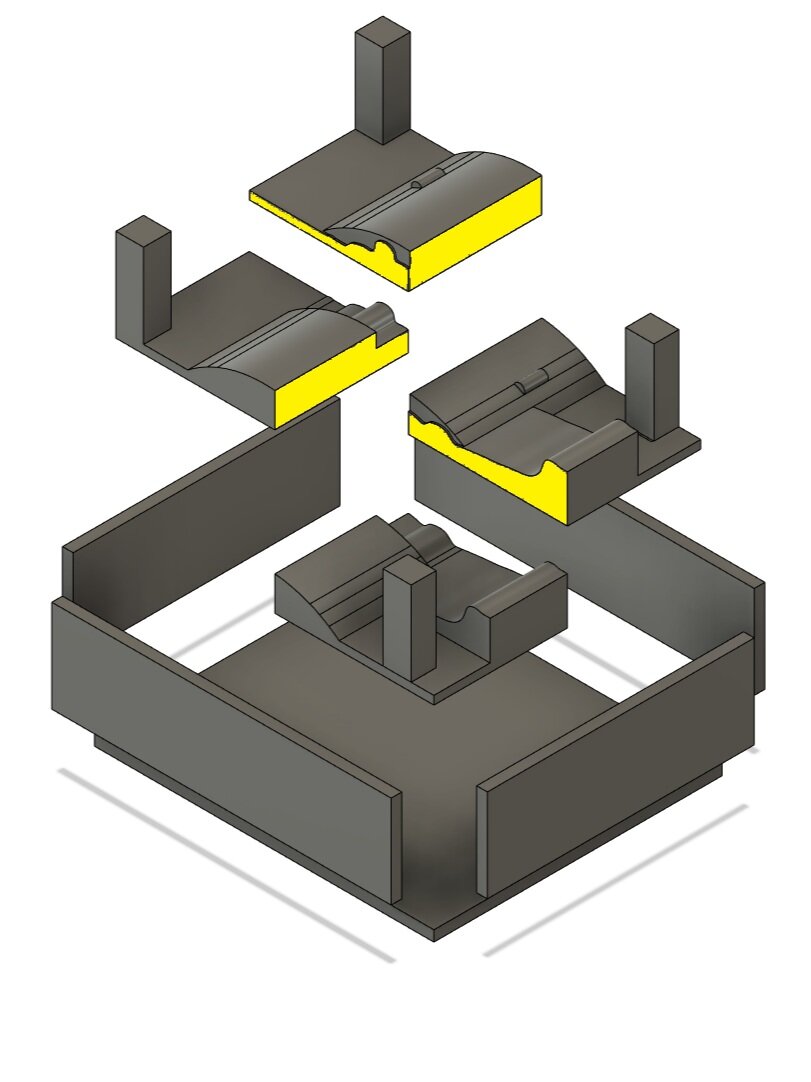Service Equipment Design
Mercedes-Benz
+
DISCLAIMER: All images utilized are property of Mercedes-Benz USA and are protected by United States copyright laws.
Project Description:
This project was performed as a collaboration with the University of North Florida and Mercedes-Benz. The issue experienced by Mercedes-Benz was difficulty and unsafe conditions when removing Electric Drive Units (EDU) from B class vehicles. The tool designed was to expedite and decrease the number of necessary technicians for the EDU removal process.
Being that this repair procedure was performed across the country in a number of Mercedes-Benz maintenance facilities, an added constraint was repeated ease of manufacture (using in-house tools).
To accomplish this task, a team of 5 mechanical engineering students (myself included) designed the above tool. Throughout this process my colleagues and I communicated with professors and Mercedes Benz Engineers regularly to add context to our design decisions.
Design Process:
Concept Generation, Evaluation, and Design
The design process began by closely observing the current removal process. Throughout this process requirements, constraints, and concerns were noted (some seen below). Research was then performed to inform brainstorming and evaluation criteria. From there down selection of ideas was performed to ensure the best solution based on safety, efficiency, ease of use, manufacturability, and comparative cost.
Rotation Angle about X
Angle of Rotation about Z
This down selection process can be summarized by the selected concept for each of the following categories:
Lift - the lift table in every Mercedes Benz maintenance facility to accomplish the necessary vertical motion for removal
Transmission Lift Table
Base Plate Assemble To Attach to Lift Table
Rotation - a transmission lift to accomplishes the range of motion necessary for removal
Reverse Engineered Transmission Lift Head
Fixture - a cast negative of the underside of the EDU to constrain the EDU during removal and reorient rotation axes
Evolution of Fixture Design
Old Rotation Axes
New Rotation Axes
Informing Material and Geometry Selection
In order to select materials and geometry, a combination of hand calculations, excel calculations., and FEA (using both NX Nastran, and Fusion 360 Nastran) were performed to prevent yield and failure. Some of these calculation setups can be seen below. Additionally, the surrounding internals of the vehicle were re-created and a mock removal process was animated to ensure clearance.
Manufacture and Assembly
The initial intention was for the entire tool to be fabricated by the team however, COVID-19 prevented the completion of this and the collection of representative progress images. My teammates and myself were able to manufacture the entire base plate assembly and the majority of the fixture box. The remaining manufacturing steps were outlined thoroughly to Mercedes Benz with available equipment in mind. To accomplish these steps, UNF’s Fabrication Lab was used (Mill, Horizontal Band Saw, Vertical Band Saw, Lathe, MIG Welder, 3D Printer, Grinder, Table Saw, etc).
Testing Procedure
Before putting this tool into repeated use, it was important to test the safety of the device. In addition to the FEA and animation mentioned above, quantitative physical testing was outlined, These procedures were to be completed by Mercedes Benz after finishing the manufacturing steps previously mentioned.
Qualitative Testing
To assess whether the removal process would be possible using the tool, the tool was to be loaded with the EDU, and the range of motion experienced during removal be replicated in place. With a factor of safety of 8 in most parts, this should be no issue.
Quantitative Testing
To evaluate the performance of the tool quantitatively, the tool was to be rigged with strain gauges (locations seen below) feeding data to an Arduino microcontroller. These values were to be compared to yield strength values and values predicted by FEA to prove performance and safety before repeated use.
Related Skills
Leadership
Teamwork
Communication
CAD (NX, Fusion 360, SolidWorks)
FEM (NX Nastran, Fusion Nastran)
Material selection
Technical writing
Fabrication
Welding
Milling
Turning
3D Printing
Casting
Presentation
Mechanical Testing
Arduino
Microelectronics




























